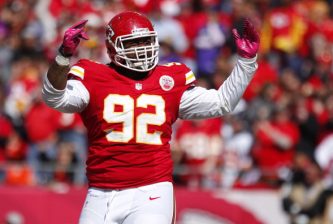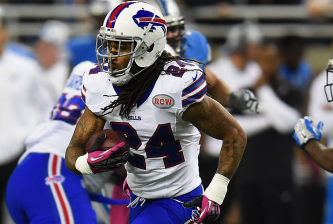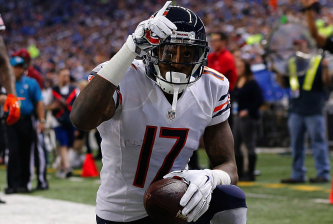Every team looks to walk away from the NFL draft with at least one difference maker. In an ideal world all your draft picks make the 53 man roster; some develop from the sidelines, others are role players quickly, and maybe if you’re lucky one will be a superstar. Drafting at least one player that will immediately come on the field and make such an impact that it translates into wins is the hope. So who are the players most likely to be “that guy” at each position on the field? We study that below:
Quarterback: Jameis Winston, Florida State (runner up: Marcus Mariota, Oregon)
Regardless of what Jimbo Fisher says, there’s red flags surrounding Winston. He’s been accused of rape, he’s been accused of stealing, he’s been suspended for shouting obscenities, he’s been questioned on his work ethic and he’s even been suspected of point shaving. And none of this really matters as most view him as a lock to be the first pick overall. But that’s just how good he is. He’s got prototypical arm strength, passing accuracy, height, power, on field moxy and resume. He’s won the Heisman trophy and he’s won the National Championship. You have to be pretty special in this day and age for an NFL team drafting 1st overall to possibly overlook all of the question marks. He’s that good, he just has to keep his head on straight.
Running back: Melvin Gordon, Wisconsin (runner up: Todd Gurley, Georgia)
Gurley was probably the guy between the two before his gruesome injury. That’s no slight against Gordon, though, who is an excellent back in his own right. Despite less importance being placed on the position, many feel Gordon will go in the 1st round because he’s just that special. He rushed for 2,587 yards and 29 touchdowns in 2014 at Wisconsin, and only two teams held him under 120 yards rushing.
Wide Receiver: Amari Cooper, Alabama (runner up: Kevin White, West Virginia)
White has been gaining some traction which his ridiculous combine that featured a 4.35 40 yard dash and a size advantage of 2 inches over Cooper. White may be the trending pick between the two, but Cooper’s production hasn’t changed. Cooper faced the best corners college football has to offer and he turned in a 124 catch 1,727 yard, 16 touchdown season. White, who played in a more wide open offense, finished with 109 catches for 1,447 yards and 10 touchdowns. Both are incredibly impressive and productive and at the end of the day both will be terrific pros. But when you consider competition faced and consistent reliability, Cooper is the man. It’s worth noting that White faded just slightly down the stretch of his season whereas Cooper got stronger with every game.
Fullback: Jalston Fowler, Alabama (runner up: Tyler Varga, Yale)
Fowler can do it all. He can run the ball, catch it, play special teams and lead block. With the fullback position being a dying breed, a player that has the versatility to help you in a lot of areas is critical. For that reason Fowler has as good of a shot at making an NFL roster as any fullback in this draft.
Tight End: Maxx Williams, Minnesota (runner up: Devin Funchess, Michigan)
Funchess is an intriguing prospect as a receiver/tight end tweener, but it remains to be seen if he can bulk up and be a true receiving tight end, or if he’ll end up being more like a Marques Colston type receiver. Williams, on the other hand, is a true tight end. He’s more of a receiving type which is a requisite in modern day NFL, but he’ll be able to develop into a solid blocker as well. There is no reason why Williams can’t become one of the more solid tight ends in the league.
Tackle: Brandon Scherff, Iowa (runner up: La’El Collins, LSU)
Scherff is a mauling lineman that could start at guard in the NFL as he develops. He already has the power to make an immediate impact in the trenches, as does Collins. These two players are fairly similar. Both were left tackles in college, though, and over time that seems to be the natural evolution for each. Both of these players seem like home run picks that will improve any offensive line immediately.
Guard: A. J. Cann, South Carolina (runner up: Tre’ Jackson, Florida State)
Both of these guys are as powerful as it gets. Jackson has a bit more size, but Cann plays a little nastier and has the low drive that will be devastating in the run game.
Center: Cameron Erving, Florida State (runner up: Hroniss Grasu, Oregon)
As a former defensive player, Cameron has the lateral foot speed to be a good pull blocker. His size is another huge bonus.
Defensive End: Leonard Williams, USC (runner up: Dante Fowler, Jr., Florida)
Viewed by many as the best player in the draft, most feel Williams is the closest thing to a sure thing in this draft that would produce an immediate impact on the field. Williams is a well rounded player that will only get better once he figures out how to best utilize the ridiculous amount of power and athletic talent he possesses.
Defensive Tackle: Danny Shelton, Washington (runner up: Arik Armstead, Oregon)
Shelton and Armstead feel weird to group together because they are fit for different systems. Shelton is a 3-4 nose player only who is a mammoth in size. He could become one of the most effective plugs in the league and really anchor a 3-4 defense up the middle. Armstead could either be a 4-3 defensive tackle, or a dominant run stuffing end in a 3-4 scheme. But while they play different positions for potentially different schemes, if we’re looking at “defensive tackle” more broadly, they are both fantastic prospects. Armstead is more of a raw player with enormous potential, though, whereas Shelton already knows his place, has polish, and can immediately step in to the right system for him.
Outside Linebacker: Shane Ray, Missouri (runner up: Vic Beasley, Clemson)
This position is hard to group because you have so many players that project as 4-3 ends that could be a 3-4 outside linebacker, and vice versa. Fowler, for example, is a player I listed as the #2 defensive end but he may have a future as a linebacker in a 3-4 system. Ray fits that description, too, though he’s more of a pass rushing specialist which makes a 3-4 OLB even more likely. Ray has the explosiveness to be a double digit sack guy for a long time in a league desperate for guys able to get to the quarterback. Don’t sleep on Beasley either, though, who had undeniable production at Clemson. Bud Dupree is another prospect that deserves mention. While he might need more coaching than Ray and Beasley, his ceiling is potentially higher if he puts it all together.
Cornerback: Trae Waynes, Michigan State (runner up: Jalen Collins, LSU)
Marcus Peters is a player that could have been listed at 2, or even 1, but his stock is lowered with the red flags that surround him. He could be a huge pay off value pick as the draft progresses, though. Waynes is the clear #1. Most viewed him as the best corner in the draft prior to the combine and he nailed the combine with flying colors. Collins is much less polished and has less production in college to his name, but has all the measurables you would dream of in an NFL corner. Collins did just have foot surgery, though, so his stock may be dropping.
Safety: Landon Collins, Alabama (runner up: Derron Smith, Fresno State)
Projected at strong safety, this is the consensus best safety in the draft and it may be a while until we see another safety drafted after him. He’s a physical presence that will give any defense a hard hitting component.
Kicker: Josh Lambo, Texas A&M (runner up: Sam Ficken, Penn State)
By far the most accurate kicker in the draft with a soccer background that makes him an intriguing pick, even at 25.
Punter: Kyle Loomis, Portland State (runner up: Trevor Pardula, Kansas)
He has a massive leg and is experienced enough to do it all after spending 3 years punting at Oregon State. Loomis is 28 as he served in the Army for several years before coming back to punt one more year in college for Portland State.
Long Snapper: Joe Cardona, Navy (runner up: Andrew East, Vanderbilt)
Viewed by almost everyone as the best long snapper in this class, he has a decent shot at getting drafted.




















